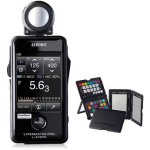I only use my light meter in a studio situation. It seems absolutely required for multiple flash units, to set each light for ratio, to know what they are doing. I use a $200 Sekonic L-308S, and it does all I need, it meters the lights. I love the meter for multiple flash.
Using one flash, you can easily just tweak it in by eye. But for multiple lights in a less casual situation, you need to know exactly what each light is doing. The idea is to set each to do what you want it to do.
For outdoors walking around in ambient, the camera meter is already pretty good, or at least convenient, and I've learned to use it.. It is reflective however, and the Sekonic will provide incident readings, independent of the colors in the subject. That can be an advantage, but frankly, I NEVER bother with a handheld in outdoor ambient, seems very unnecessary. Shooting Raw, I just tweak it a little in post if necessary. Whereas, indoors with umbrellas, the camera cannot meter manual flash, and I can take whatever time it needs when setting up.
So there seems two baseline situations, to control the lights to be what you want them to be, or to just accept whatever light you find on scene.
More thoughts on it at
Why would I need a handheld light meter?


